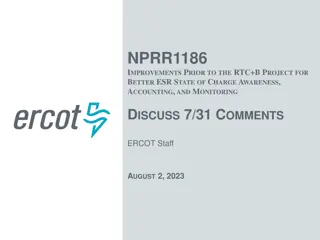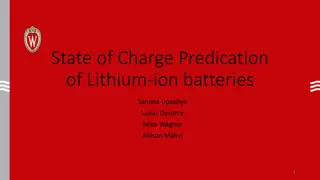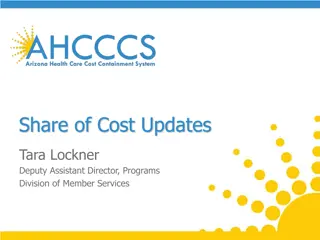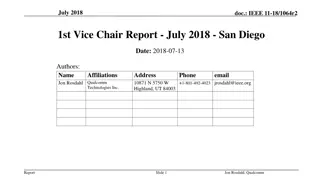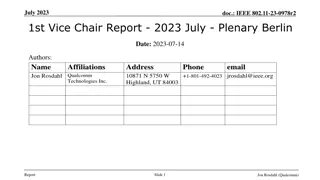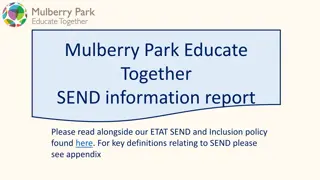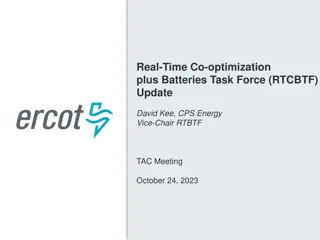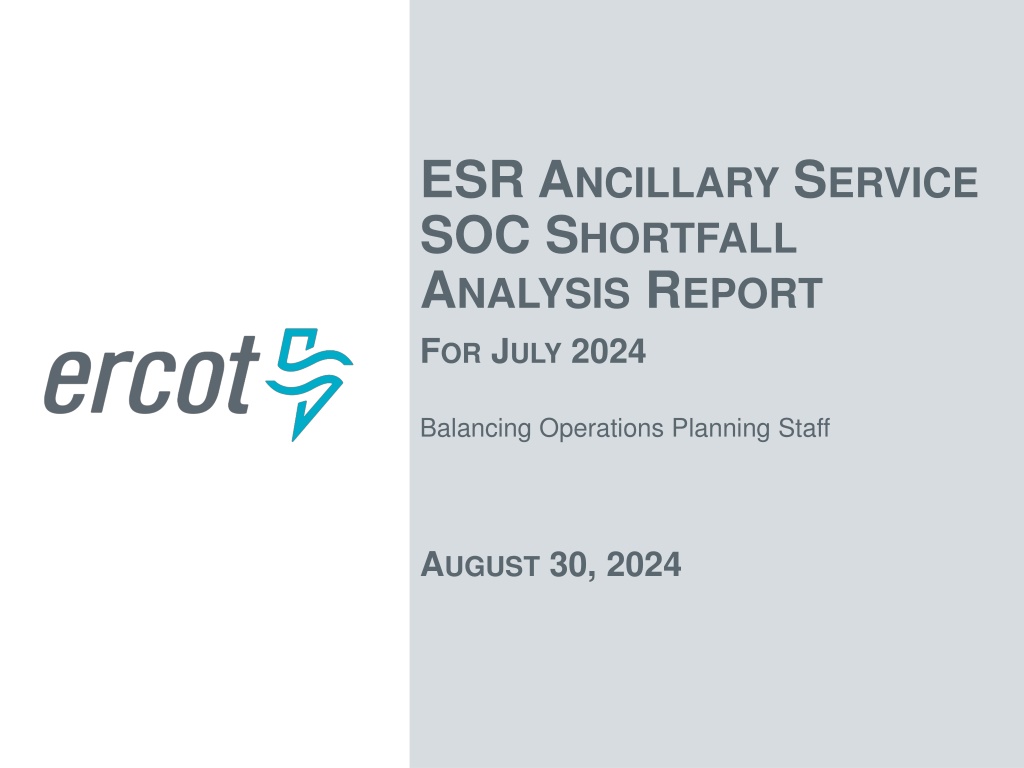
Ancillary Service Shortfall Analysis Report - July 2024
Explore the analysis of insufficient System Operating Condition (SOC) to meet Ancillary Service Obligations in July 2024, including shortfall conversion to MW values, cost determinations, ESR performance evaluations, and more.
Download Presentation

Please find below an Image/Link to download the presentation.
The content on the website is provided AS IS for your information and personal use only. It may not be sold, licensed, or shared on other websites without obtaining consent from the author. Download presentation by click this link. If you encounter any issues during the download, it is possible that the publisher has removed the file from their server.
E N D
Presentation Transcript
ESR ANCILLARY SERVICE SOC SHORTFALL ANALYSIS REPORT FOR JULY 2024 Balancing Operations Planning Staff AUGUST 30, 2024
Insufficient SOC to provide Ancillary Service Obligations if system conditions require (Month over Month) An ESRs Shortfall is converted a to MW value and system-wide AS MW Short is computed for every hour (referred to as MW Short). Ancillary Service Shortfall costs are determined using MW Short and historical MCPC. * % Short of AS Responsibility = (Monthly ESR MW Short / Monthly ESR AS Responsibility)*100 ** % of AS Cost = (Monthly AS Shortfall Cost from ESRs / Monthly Total MCPC of the AS Carried by ESRs) * 100 Observation: In July, ESRs were approximately 0.4% Short of AS Responsibility, resulting in approximately 0.53% of the Total AS Cost carried by ESRs. 2 PUBLIC
Inadequate response from ESRs during unit trips when carrying RRS with low SOC^ This data is sourced from the ERCOT BAL-TRE-001 FME tool. Low SOC is determined using telemetered SOC, MXOS, MNOS. SOC % = ((SOC-MNOS)/MXOS)*100. * RRS-FFR performance is determined solely on sufficient MW response being provided. ** FMEs and Non-FMEs which were reported to PDCWG. ^ Low SOC is set to 20% for this analysis, this is a configurable parameter. RRS-PFR RRS-FFR Low SOC ESRs Low SOC ESRs Evaluated ESRs Evaluated ESRs Frequency Events** Event Date Failed Failed* Evaluated Evaluated 5/12/2024 2:51 66 0 0 0 0 0 FME 5/22/2024 18:36 31 0 0 0 0 0 Non-FME 6/2/2024 22:24 52 0 0 0 0 0 Non-FME 6/3/2024 23:19 51 0 0 0 0 0 Non-FME 6/4/2024 22:39 46 4 1 0 0 0 Non-FME 6/29/2024 19:57 45 0 0 0 0 0 FME 7/23/2024 5:26 38 6 1 0 0 0 Non-FME 7/24/2024 7:02 43 7 0 0 0 0 Non-FME Observation: In July 13 ESRs carrying RRS evaluated during unit trips had a low SOC, 1 of which failed. 3 PUBLIC
Inadequate output following dispatch setpoints when carrying AS with low SOC^ GREDP and CLREDP formulas from Protocols are used to compute how closely an ESR providing Ancillary Services followed its setpoints* in low SOC intervals. Low SOC is determined using telemetered SOC, MXOS, MNOS. SOC % = ((SOC-MNOS)/MXOS)*100. * Setpoint is calculated as Base Point + regulation instruction + expected PFR. ^ Low SOC is set to 20% for this analysis, this is a configurable parameter. ESR GREDP Interval Failures ESR CLREDP Interval Failures Total Intervals on Low SOC with AS Month July 2024 38 582 1648 Observation: In July, there are 38 intervals where ESRs failed GREDP with low SOC and AS Responsibility. 4 PUBLIC
Questions? Please reach out to Luis Hinojosa (JoseLuis.Hinojosa@ercot.com) and Sam Fabricant (Samuel.Fabricant@ercot.com) 5 PUBLIC
Appendix 6 PUBLIC
ESR AS MW Shortfall Introduction NPRR1186 brought improvements to ERCOT systems to better account for state of charge (SOC). These changes now allow ERCOT s EMS to preserve SOC in SCED dispatch to maintain needed SOC to support Ancillary Service (AS) obligation in the remainder of the hour. ERCOT is posting this report to provide insights into insufficient SOC to provide AS obligation and inadequate response to events and dispatch potentially due to low or insufficient SOC. The charts on slide 2 is built using SOC shortfall calculations over the hour which are converted to a MW shortfall value. Shortfall for each AS are assigned in this order (Non-Spin, ECRS, RRS, Regulation and FFR). AS Shortfall Cost ($) is calculated using the Market Clearing Price for Capacity (MCPC) of the Ancillary Services and the MW Short amount for each Ancillary Service for QSEs. 7 PUBLIC
Insufficient SOC to provide Ancillary Service Obligations if system conditions require Observation: The QSEs with the most MW Short in July tend to be short in HE21-24. 8 PUBLIC
Insufficient SOC to provide Ancillary Service Obligations if system conditions require Shortfalls are converted to MW values (referred to as MW Short) and grouped by HE and Day of the month. Ancillary Service Shortfall costs are determined using MW Short and historical MCPC. Observation: Top 3 day with largest AS MW short due to SOC: July 5, July 4, July 18 Top 3 day with largest AS $ short due to SOC: July 4, July 1, July 15 Top 5 Hours with AS MW short due to SOC: HE22, HE23, HE21, HE24, HE9 9 PUBLIC
Insufficient SOC to provide Ancillary Service Obligation Example Example: AS Responsibility of 60 MW while only telemetering 30 MWh of SOC throughout the hour. This ESR would contribute 9.2 MW RRS Short for this hour. This hour would be considered a Shortfall Hour due to meeting the proposed NPRR1186 shortfall threshold metric at the end of the hour. (Integrated SOC shortfall exceeds the greater of 2MWhh or the lower of 8MWhh or 20% of the integrated SOC expectation) Attached is an excel workbook that can be used to explore shortfall scenarios in more detail. Insufficient SOC Calcuations.xlsx 10 PUBLIC This slide is sourced from mock data to demonstrate report capabilities.


